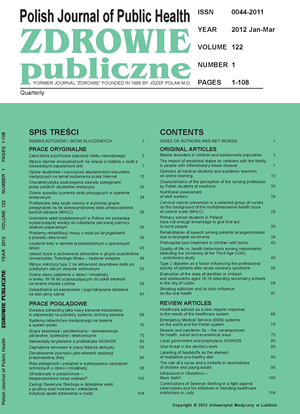Mental disorders in children and adolescents population
Keywords:
mental disorders, children, adolescents, developmental ageAbstract
Introduction. The definition of World Health Organization, according to which health is a state of complete physical, mental and social well-being and not merely the absence of disease or infirmity, indicates a broad perspective at which the phenomenon of health should be regarded and analysed. Diagnosing mental disorders in patients of developmental age is associated both with the difficulties arising from the dynamics of development and with the genetic heritage, injuries of central nervous system, organic disorders or the pathology of the environment.
Aim. The paper aimed at analysing the cases of patients treated due to mental disorders during the last two years at the Department of Paediatric Psychiatry of the Neuropsychiatric Hospital in Lublin.
Material and Methods. The analysis based on the medical documents of children hospitalized at the Department of Paediatric Psychiatry covering the period from January 2010 - December 2011.
Results. During the study period 497 patients were admitted to the department. In this group there were significantly more boys (352) than girls (145).The age of children ranged from 6 years to 16 years of age. Patients at preschool age (3-6 years) accounted for 4% of the total, in adolescence (13-18 years) 47%. The largest group(49%) were children of school age (7-12 years). The largest number of admissions to the department was reported in March (50), the smallest in July (26). The largest group of 336 persons admitted to the department during this period consisted of patients hospitalized with a diagnosis of F90-98 “behavioural and emotional disorders with onset usually occurring in childhood and adolescence”. The shortest hospital stay was 1 day, the longest – 101 days.
Conclusions. Mental disorders of the studied group of children and adolescents concern to a greater extent boys than girls. There is a clear correlation between the season of the year and the number of hospital admissions. During the summer holiday season this figure was clearly lower as compared to the winter season. This may suggest the influence of school environment being a stress-generating factor triggering the disorder. The data analysis confirms that the behavioural and emotional disorders account for the highest proportion of pathology as far as mental disorders of children and adolescents are concerned.
References
1. http://www.who.int/topics/mental_health/en/Access from 23.01.2012 r.
2. Pużyński S, Wciórka J. Klasyfikacja zaburzeń psychicznych i zaburzeń zachowania w ICD-10. Badawcze kryteria diagnostyczne. Warszawa: Uniwersyteckie Wydawnictwo Medyczne VESALIUS; 2000.
3. Wciórka J. Kryteria diagnostyczne według DSM-IV-TR. Wrocław: Elsevier Urban & Partner; 2008.
4. Popielarska A, Popielarska M. Psychiatria wieku rozwojowego. Warszawa: Wydawnictwo Lekarskie PZWL; 2000. p. 14.
5. Goodman R, Scott S. Psychiatria dzieci i młodzieży. Wrocław: Wydawnictwo Medyczne Urban & Partner; 2000.
6. Craddock N, Kerr M, Thapar A. Jakie są najważniejsze umiejętności psychiatry? The Psychiatrist. 2010;34:457-60.
7. International Classification of Impairments, Disabilities and Handicaps.
8. Zastosowanie psychoterapii poznawczo-behawioralnej zespołu obsesyjno-kompulsyjnego u dzieci i młodzieży. Prowadzenie psychoterapii poza gabinetem. Psychiatr Psychol Klin. 2011;11(2):92-9.


